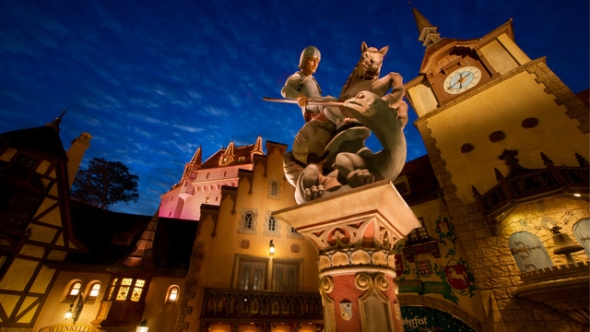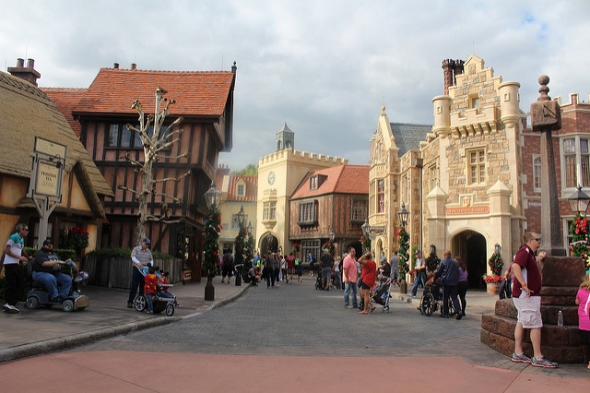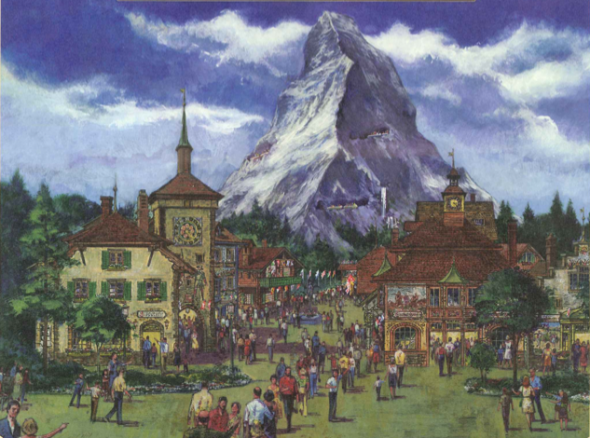This all seems great! Why did the pavilions stop?
Image: Disney
By telling this story out of order, I’ve shown you exactly how the process looks from Disney’s side. With the first 31 requests, they faced sound rejection. Every possible country swiped left. Then, when Disney offered to pay, nine countries expressed the marginal interest needed to proceed. After those pavilions all worked well, EPCOT Center officials enticed two other countries not just to participate but also to pay for everything.
Your confusion at this moment is understandable. If Disney could broker deals like this, why wouldn’t they continue? No downside exists to a deal where one party boosts the appeal of their park while the other pays for everything. Alas, it was never that easy.
What I’ve detailed are the “success” stories, some of which required a great deal of Disney coercion and hefty financial outlays from the corporation. The other side of the equation involves the failed negotiations. A shocking number of these exist. Let’s start with Israel, a country who actually signed a contract to join Epcot. Does that surprise you? Would you be shocked to learn that Disney sent out a press release trumpeting this agreement? It’s absolutely true.
Here’s the pertinent text from the 1981 statement: “The Venezuelan pavilion joins a number of countries and areas of the world scheduled for addition to the eight inaugural World Showcase nations. They include: Mexico, China, Germany, Italy, Japan, France, the United Kingdom and Canada. Venezuela, the State of Israel and Equatorial Africa are among the Phase II pavilions planned.”
Yes. Wait, no. Well, maybe. Whose name will go first?
That last sentence likely confused you so much that you had to read it again. It’s not your imagination, though. All of those pavilions were close enough to construction that Disney felt ready to announce them to the press. None of them wound up breaking ground. What went wrong? A little bit of everything is the depressing answer.
Nervous members of Disney’s board expressed concerns about Israel’s presence. EPCOT Center was supposed to grow the Walt Disney World brand by encouraging even more tourists to head to central Florida. The presence of an Israel Pavilion sadly caused worry about terrorism. Even 35 years ago, park planners fretted over security concerns involving EPCOT Center, as did federal investigators.
While the rich history of the Israeli people seemed like a wonderful augmenting of the World Showcase, park officials believed that the best case scenario for the Israel Pavilion would involve frequent protests. Disney never officially updated the public on this venture, but their fears were later validated, at least somewhat, in 1999. The Arab League called for a boycott of Epcot due to its 18-month Millennium Village addition, which included a temporary Israel Pavilion.
As for Venezuela, they joined Spain on the list of countries with governments who longed to add a presence at EPCOT Center. Both countries paid the $500,000 required to design blueprints for a pavilion, a Disney requirement for potential Phase II participants. Alas, their governments changed hands or lost influence and financial flexibility around this timeframe, causing current or new regimes to back away entirely.
The heartbreak here is that the blueprints for these pavilions are available online. If you decide to look at them, you’ll note that Venezuela would have featured an aerial tram that guides you through the rainforest. Spain’s blueprints were even more ambitious. They included two attractions, which is double what any current pavilion possesses. Those aren’t even the most tantalizing plans, though.
Image: Disney
When Norway struggled to come up with the $30 million required, other countries from the region pounced on the idea of a pavilion representing several countries. Once Norway’s corporations found the money, Switzerland’s government plotted their own pavilion. They didn’t want to cede tourism to Norway. One of the most exciting plans ever for the World Showcase almost became a reality. The Switzerland Pavilion would have included a Walt Disney World version of The Matterhorn.
Perhaps the strangest collapse of a deal is the one I referenced earlier. Disney announced an Equatorial Africa Pavilion in 1980. The Ivory Coast, Kenya, and Senegal all agreed to join forces for a joint pavilion. Each one signed paperwork, and the economics of the agreement weren’t an issue. The reason this pavilion doesn’t exist today is infuriating.
The countries squabbled over whose name should go first on the various listings. All three of them would enjoy equal representation and a windfall of tourism from the agreement. Jingoism prevented that from happening. Unreasonable national pride led to all parties walking away, leaving Disney execs feeling bitter about the experience.
In fact, let’s examine the situation from Disney’s perspective. It’ll enlighten you on why the World Showcase has remained static for the body of three decades. After originally going 0-for-31 in persuading countries to join, Disney finally got nine to play along…as long as Disney paid.
After these nations agreed, others changed their stance, at least slightly. Over the course of a decade, Disney entered negotiations with Costa Rica, Denmark, Iran, Israel, Ivory Coast, Kenya, Russia, Senegal, Spain, Switzerland, the United Arab Emirates and Venezuela. Eleven countries currently have a presence at the World Showcase. That’s *12* others Disney desperately worked to add to the park, failing in each instance. Out of those missing dozen, only Israel isn’t there due to Disney’s choice.
Why are there no new World Showcase pavilions? Getting 11 was such a nightmare that it’s completely understandable why Disney eventually just gave up.




Comments
Interesting article! It certainly puts the conversion of Maelstrom into Frozen in a new light. By placing such a popular property into World Showcase, Disney is likely hoping for increased visits (and revenue) for EPCOT. If business gets better, it could be a deciding factor for nations still on the fence about pavilions of their own.
Disney doesn't seem to know what to do with Epcot. Futureworld just closes things and doesn't replace them. It's kind of sad to walk around there. I don't have any ideas for that except just don't make the place seem like a graveyard.
The Food and Wine festival proves how popular a world showcase can be.They should just bite the bullet and pay for more countries. There don't even have to be rides, just more culture. I think additions of countries could reinvigorate the park.